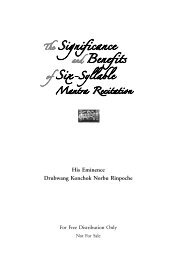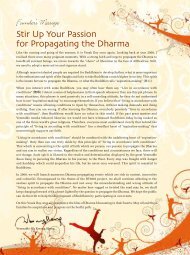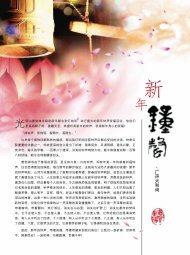Editor's Note - Dharma Resources - Kong Meng San Phor Kark See ...
Editor's Note - Dharma Resources - Kong Meng San Phor Kark See ...
Editor's Note - Dharma Resources - Kong Meng San Phor Kark See ...
You also want an ePaper? Increase the reach of your titles
YUMPU automatically turns print PDFs into web optimized ePapers that Google loves.
Ven. Dr Chang Qing, Dean of<br />
Academic, Assistant Professor of<br />
the Buddhist College of Singapore<br />
gives us a basic understanding<br />
of this simple and yet profound<br />
method of Buddhism.<br />
The Basics of ZEN Meditation<br />
Feature<br />
awaken<br />
42<br />
T<br />
here are eight schools of thought that are<br />
institutionalised in Chinese Buddhism.<br />
However, Pure Land and Zen Buddhism are the<br />
more influential of the eight schools that more<br />
people around the world practise. In Buddhism,<br />
Pure Land is considered an “easy-path” ( 方 便 道 ) to<br />
attain enlightenment. Many Buddhists maintain the<br />
idea that this school of thought only emphasises on<br />
repeatedly chanting the name of Amitabha Buddha.<br />
Doing so, is tantamount to gaining entrance into the<br />
Pure Land when they finally perish from worldly<br />
life. Unfortunately, it is not as effortless as what<br />
they envisage. Before anyone can ascend to the Pure<br />
Land, some prerequisites have to be met. Similarly,<br />
Zen Buddhism also prevails everywhere. Let us<br />
focus our attention on “Zen meditation” ( 禅 坐 ).<br />
Zen and its many names<br />
Zen meditation is known by many names. It is called<br />
dhyana in India, Chan ( 禅 ) in China and Zen in Japan.<br />
So what is so mystical about Zen Zen signifies the<br />
elimination of evil and generation of merits. In Tachi-tu-lun<br />
(Mahaprajna paramita-sastra), Zen is<br />
described as the “Practice of Contemplation”( 思 惟 修 ).<br />
The new connotation is “Silent Deliberation” ( 静 虑 ).<br />
One of the Buddhist treatises regarded Zen as the<br />
origin for non-arising of the deluded mind. In other<br />
words, Zen could be deemed as pure-mind, wisdom,<br />
<strong>Dharma</strong> and truth.<br />
In reality, “Zen meditation” ( 禅 坐 ) and “Meditation”<br />
( 静 坐 ) are two very different entities. “Meditation” is<br />
akin to “pilates”. There are no underlying religious<br />
elements, and its main objective is to exercise the<br />
body and perhaps to cultivate mental health. In<br />
Buddhism, “Zen Meditation” is to practise the<br />
reflection of the Buddha’s teaching (<strong>Dharma</strong>)<br />
while meditating. Zen symbolises wisdom by<br />
contemplating the <strong>Dharma</strong> with meditation in order<br />
to generate wisdom. The above explanation spells<br />
out the crucial difference between the two kinds of<br />
meditation.<br />
The purpose and function of Zen<br />
According to Master Sheng Yen, the purpose of Zen<br />
is to neutralise the deluded mind.<br />
In Buddhism, delusion is the main<br />
source of affliction and leads to worldly<br />
suffering.<br />
External and internal objects are the main culprits<br />
of delusion. By practising Zen meditation, we could

















